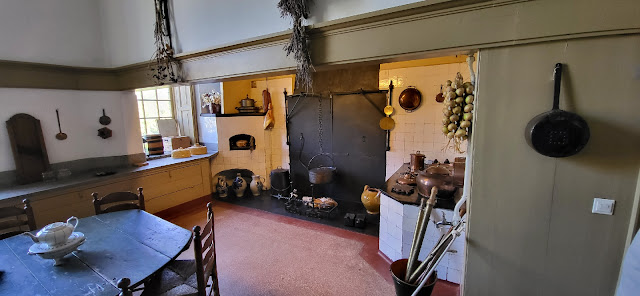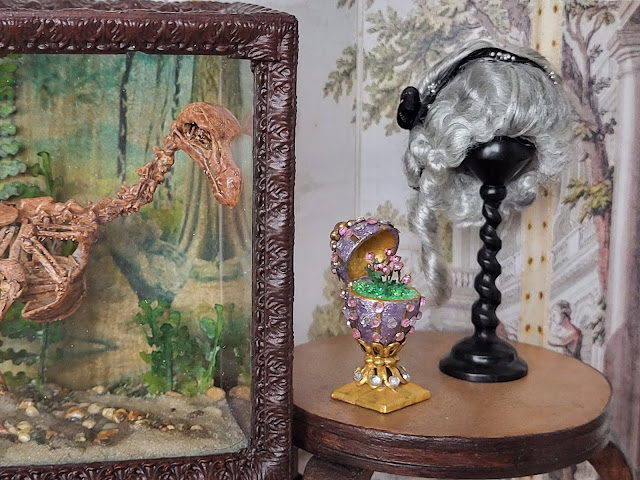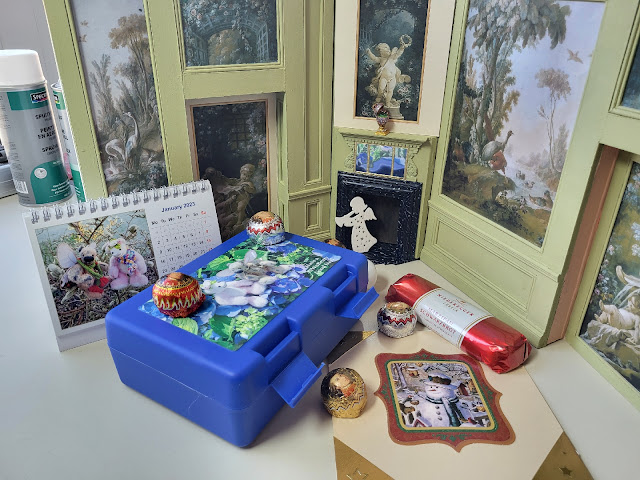Well that is it for now. I hope that you have liked this post. No miniatures this time, but I'll be back soon with some more about that.
Huis ter Swinnendael, een buitenplaats in miniatuur.
Wednesday 22 February 2023
Visiting grand houses: The other Belle
Well that is it for now. I hope that you have liked this post. No miniatures this time, but I'll be back soon with some more about that.
 I am a lover of art, books and miniatures. I like to plan ahead and take on projects that are too big, or at least a challenge, to accomplish. Such a project is Huis ter Swinnendael. A fictional late 17th country estate in the Netherlands.
I am a lover of art, books and miniatures. I like to plan ahead and take on projects that are too big, or at least a challenge, to accomplish. Such a project is Huis ter Swinnendael. A fictional late 17th country estate in the Netherlands.
Wednesday 15 February 2023
Whom the whig fits... and other (birthday) presents!
Hello my friends,
In 1806, the year I want to set the scene for Huis ter Swinnendael, whigs has gone out of fashion. Fanciful powdered whigs had dominated fashion for the elite almost 200 years, but that fashion statement of the Ancien Regime found its end in the French revolution. That did not mean that nobody wore whigs anymore. Some, mainly elderly people, kept wearing them. Out of habit or because they were not eager to show what was left of their hair after a life time of wearing whigs.
And naturaly the differences in fashion did not stop there as the old cartoon below shows us. And the victor dictates the tone. Note for example the calm posture and sarcastic bemusement of the revolutionary couple's reaction, versus the indignant (slight panic) reaction of the startled proponents of the old regime. The nobles that are out of touch with the new times.
 |
| "Ha! What an antiquity" "Oh! The madness of this novelty..." |
I imagine that for Carel Polyander and Annabelle Zonneschut, time has somewhat stood still since the Batavian revolution started in 1795. They are not blind to all the events of their time of course, but within the domain of their country estate they do not feel the need to follow fashion anymore. they have withdrawn from society more or less and can cultivate what they would like to preserve.
And when the new fashions are promoted by the revolutionary new elite, that is all the more reason for them to not adopt them. The Zonneschuts comfortably live in their own bubble now. The servants may agree or disagree but they will wisely keep their opinions to themselves. In short, this attitude of the residents of the house I'm building, means that 'madame et monsieur' still wear whigs.
,_echtgenote_van_Willem_V,_prins_van_Oranje.jpg) |
| Princess Wilhelmina, by Johann Friedrich August Tischbein in 1789, Mauritshuis museum |
The picture above is of Princess Wilhelmina of Prussia. She was the wife of Prince William V who fled to England in the early days of the revolution of 1795. Her whig shows one of the latest fashions for whigs in the same year the attack on the Bastille in Paris started on the 14th of july. Therefore I wanted Annabelle to at least have one whig in this style.
I asked Annemarie Kwikkel Smith, who makes stunning period dolls, if she would be interested in making this type of whig for me. Normally she does not make loose whigs, but she loved the idea I have for my house and the family that occupies it. So she loved to accept the commission.
Luckily I planned on going to a miniatures fair in the last weekend of january. On that fair, Annemarie and I met eachother. It was great to see each other in real life. It makes it much more personal than just communicating by email. She had finished the whig already and gave it to me. I was amazed by the whig. So beautiful!
And what surprised me even more was that she would not let me pay for it. She wanted to give it to me as a present! Very gratefully I thanked her and took the whig home whith me. Now it awaits the new whig stand so that I can take this beautiful hairpiece out of its box and display it in the dressing room. Since my birthday was only two weeks away I regard it also a bit like a birthday present!
Annemarie, if you read this, thank you again for this spectacular gift! It will soon find its place in the dressingroom as soon as I have a suitable whig stand to display it.
At the same fair I also bought a few other pieces. For example this three legged Queen Anne style table made by Ericson Miniatures. And a few kits for furniture and flowers. You will see more of these when I get round to assembling them.
Amidst all the yummy treats and lovely presents as shown on the picture, there was also a special gift made by Birgit. A stunning Faberge style egg! A luxurious miniature with microscopic mini flowers.
Thank you again Birgit! It will get its pride of place among my other Faberge eggs. We should however give your egg a name. Since all the Russian eggs have names also.
Can you all help me think up a good name? Suggestions are welcome.
 I am a lover of art, books and miniatures. I like to plan ahead and take on projects that are too big, or at least a challenge, to accomplish. Such a project is Huis ter Swinnendael. A fictional late 17th country estate in the Netherlands.
I am a lover of art, books and miniatures. I like to plan ahead and take on projects that are too big, or at least a challenge, to accomplish. Such a project is Huis ter Swinnendael. A fictional late 17th country estate in the Netherlands.
-
The Italian Garden It is always a question of the right perspective. Is it not? Hello my friends, What to do in the...
-
Hello my friends, After decorating a bunch of gilded and/or ebonised picture frames, it was time for something different. And I ...
-
Hello my friends, I promised that my next post would be the finished dressing room of lady Anne Belle Zonneschut. But th...
-
Hello my friends, This is already the fourth post in November. I am certainly catching up on lost time/posts, of the last few month...
-
Hello my friends, August has been a lost month for miniatures in my case. A heatwave with a record length (for the Netherlands) did not hel...

























